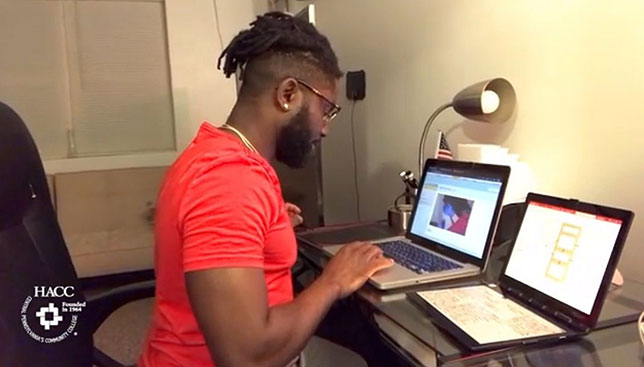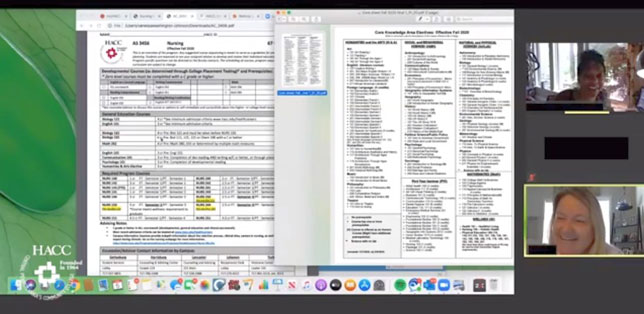7 Ways to Show Students You Care
This Pennsylvania community college uses a combination of fun, funding and informing to keep their learners in the fold.
- By Dian Schaffhauser
- 11/04/20

HACC student studying remotely
Community colleges have a tough job when it comes to generating fuzzy feelings among their students. Typically, students commute, which means they aren't immersed in campus activities to the same extent that residential students are. The colleges' stadiums and arenas don't draw tens of thousands of enthusiastic alumni fans to watch school teams play to victory. And more of their students are part-time (62 percent for fall 2019 enrollment) than full-time (38 percent). The effort of playing up campus spirit has become more challenging now that most students are staying home for their education. Largely absent for many community college students, for example, is the connection of belonging to a small cohort going elbow-to-elbow through the same job training regimen. Preliminary numbers from the National Student Clearinghouse show that enrollment in public two-year colleges for fall 2020 is down by 7.5 percent, the largest drop of enrollment in any undergraduate segment.
Rather than giving into this downward drift, however, HACC, Central Pennsylvania’s Community College is pulling out all the stops to engage students in the life of the college. Even though the school has already announced plans to have its campus remain closed through the spring 2021 semester, a combination of cornball antics and well-considered business decisions with financial implications is keeping students in the fold.
Here are seven ways HACC (pronounced "hack") is reaching out to its students.
1) Cover Tech Needs

John "Ski" Sygielski
Yes, every school in America has struggled to outfit students with laptops and access to the internet. HACC heard early on from students that many had old computers without webcams or had to do their online work outside of businesses or libraries with WiFi. The school jumped into action, purchasing and lending out laptops, mobile hotspots and webcams to students. And it's still doing that, said John "Ski" Sygielski, president and CEO of HACC.
The college also realized it had to provide training to students, average age 25, on the technology that was being used — particularly Zoom. "It's not hard. We're grateful that the technology is easy," explained Ski. "But training programs for the students was an important piece."
2) Make Communicating "Huge"
Communication at HACC takes the form of online forums and regular e-mails. Every week, Ski hosts a college-wide Zoom event. For a while those were dedicated twice a month to students in particular, to find out what they were struggling with and how the school could help. They've since backed the student forums off to once a month. Those are recorded and made available online.
The e-mails have been just as important. The college hosts a website where people — students, staff and faculty — can submit questions. Every day through March and the beginning of April, Ski would send out separate e-mails, one to students and another to employees, sharing current information. The e-mails would close with FAQs, to answer the questions that came in. He only stopped the daily cycle of missives "when we started to see that the questions were dying down a bit." Then it moved to a few times a week and then twice a week, and that's still the frequency. "Communication was huge," Ski noted. "[We've had] so many compliments from employees as well as students [about] trying to keep them apprised."
3) Have Fun
The college used student activity fees to support remote and virtual social programming, including online music bingo, trivia contests and escape room challenges with prizes; Zoom student hangouts; lunch and learn sessions with guest speakers and caricature artists; and "5-minute cooking meal" lessons with Chef Tom Long, the director of dining services.
"Part of a collegiate experience is having fun, and so having college bingo or 'Zingo' among our students provides them with an opportunity to engage with their peers, break up the monotony of what's going on, and try and build virtual community," said Ski.
4) Run Contests and Hand Out Money
Earlier this year, HACC ran contests to give away tuition money. First, it was $500 for entries that asked students to post videos about how the pandemic affected them. Then it was $1,000 for filling out a form. Then 40 $2,000 scholarships were given away for the fall semester. More recently, the school handed out 100 $500 tuition giveaways to current students.
"It caused a good buzz," said Ski. "Our students raise families, work jobs and come to HACC to create a better future. The pandemic has left some current and future students unemployed or caring for family at home. A $2,000 giveaway covers nearly nine credits and can have a life-changing impact on a student."
The contests are also a way to draw in students who might be "on the fence," Ski offered. "We're hearing a lot of people talk about taking a gap year. I don't know what they would do in a gap year since nothing's really open. But if they're an incoming freshman or sophomore, maybe they'll decide to take a couple classes at HACC and transfer those classes when the four-year schools open up. It's an opportunity to come to HACC, see that they can do a lot here instead of going to their four-year school. So we're happy about that."
Funding for all of these was provided by the HACC Foundation. "I've worked at three institutions, and this truly has been the most generous, the most thoughtful, the most caring, the most creative, most innovative foundation board that I ever worked for," Ski asserted.
Then there have been the other donations:
- A $100,000 contribution from HACC's Student Government Association has provided students with resources to address food and housing insecurity and financial crises through a new Consultation, Advocacy, Referrals and Empowerment (CARE) Center, set up by HACC to connect students remotely to resources in the community and at the college;
- 50 $100 gift cards from PNC Bank to help students with food, housing and other necessities;
- Portions of federal stimulus checks from two generous employees to assist students with tuition; and
- Five full-ride scholarships to future students who are frontline workers or unemployed.
5) Forgive Loans
The foundation also provided more than $70,000 in "fresh start grants," intended to eliminate the past-due balances of 515 students who were financially affected by the pandemic. For some of them, the balances may have been as low as $20, said Ski. But even that amount can be "insurmountable" for people who have been laid off or are suffering from other economic setbacks, he suggested. "[We don't want to] hold them back from applying."
For similar reasons the college has done away with application fees. "We heard from students that it was more than they could handle," he said. "They had to cover bus fare. They had to take care of their kids' daycare. They had food and shelter to pay for and all the rest of it. To burden them with a $20 or $30 fee that could stop them from applying, changing their lives, finishing their degrees — $20? Really?"
6) Broadcast Availability of Advising
The same week in March that the college moved to remote delivery of instruction, it also launched its "remote drop-in advising." Advising appointments are available online or by phone. The count increased from about 700 in February to between 2,500 and 3,000 in subsequent months. April alone saw 5,314 appointments, each staffed by a professional adviser, scheduled in 15-minute increments.

A HACC student advising session
"We came to realize students needed to know that all of this stuff was going to continue to happen, but it was going to be online" noted Ski.
The main topics students wanted to discuss? The same ones advisers would see in normal times: scheduling classes, taking placement testing, adjusting classes and changing majors. But this time, students didn't have to make a special trip onto campus to get their questions answered.
The college also began promoting new counseling services more extensively. In November 2019 HACC had entered into an agreement with Mazzitti & Sullivan EAP Services, to provide clinical mental health counseling services to students enrolled at the school. The agreement provides for up to three counseling sessions per semester for a student in need, delivered online or by phone. The arrangement replaced on-campus wellness counselor services, which were running about $1 million per year, according to HACC.
7) Stay Innovative
In June, the college introduced a contact tracer training program. The $429, 45-hour, four-week training course, developed by the school's continuing education department, includes live lectures online and independent work. One unexpected outcome was the pickup by local school districts, hospitals, businesses and state agencies that wanted to send people through the training.
While HACC doesn't know whether the classwork will lead to jobs, the state has made no secret of the demand. On July 31, the Pennsylvania Department of Health, which already had 654 contact tracers, announced a $23 million federal contract with Insight Global to oversee hiring and training of an additional thousand paid contact tracing professionals to work with local and regional health entities. By Sept. 11, 1,032 contact tracers were employed by the state or serving as volunteers.
That's the kind of training opportunity that community college presidents tend to jump on. "We were quite delighted really with the positive way that [the program] was received and how we were able to engage with new individuals in our service region," recalled Ski. "We had never worked with a couple of the agencies that called us and so that was a nice entrée for us into those organizations."
What's Been Lost and What's Been Found
No, HACC enrollment hasn't beaten the odds. Its fall 2020 enrollment of 15,505 represents an 11.7 percent decline from its fall 2019 enrollment of 17,559. However, that decline is more significant for new students (down by 11.5 percent) than continuing students, whose enrollment dropped by 7.1 percent. The shrinkage was larger among Hispanic students (down by almost 21 percent) and Black students (down by nearly 17 percent) than White students (down by 11 percent). Also, overall, HACC students are taking fewer credits in fall 2020 than they did in fall 2019, a sign, the college reported, "of the economic impact the pandemic has had on our students and their families."
But while Ski is quick to point out that he misses engaging with students and others on campus daily as a result of coronavirus, he said he refuses to focus on what's no longer possible.
"I don't see this as negative," he said. "I'm excited about some of the conversations we're having with vendors, with other educational institutions, to partner in ways that we've only talked about. It's really catapulting higher ed to be much more responsive and able to meet the needs of our business community and the community in general. Even though we said we were nimble and agile before, [this time in history] is allowing us greater opportunities to be more flexible, more innovative in our delivery. I see great opportunities through this."